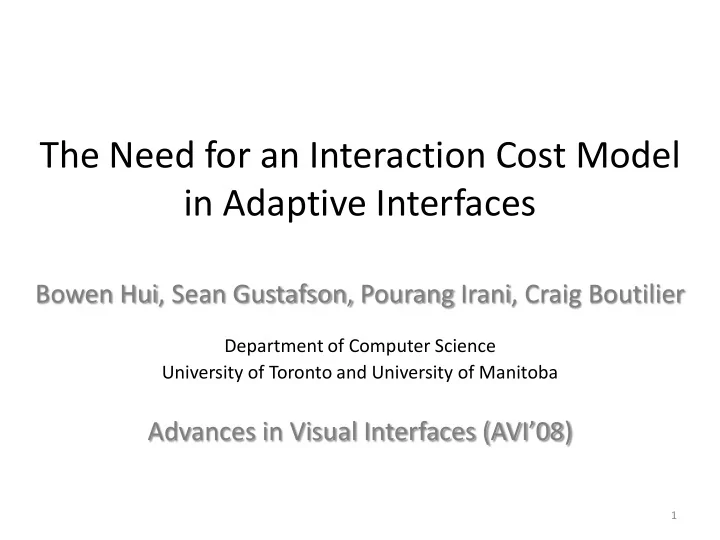

The Need for an Interaction Cost Model in Adaptive Interfaces Bowen Hui, Sean Gustafson, Pourang Irani, Craig Boutilier Department of Computer Science University of Toronto and University of Manitoba Advances in Visual Interfaces (AVI’08) 1
Need for Software Customization • Increasing complexity – Lost in interface/functionality – Repeated customization effort • Most affected users – People with cognitive, sensory, motor impairments – Elderly people – Children – Novices 2
Intelligent Interfaces • Design objectives – Minimize user effort – Maximize ease of interaction • Existing implementations: – Auto-completion – Toolbar suggestions – Adaptive menus (add/hide/move) – Etc. 3
Research Objectives • Account for existing interaction factors • Predict costs/benefits of interaction • Explain individual differences 4
Decision-Theoretic Framework • Actions lead to outcomes probabilistically • Impact of intelligent actions • Tradeoffs between costs and benefits • Maximizing (long-term) expected utility 5
Utility of Customization Actions • Impact of actions: Action Savings Processing Occlusion Bloat Disruption Interruption X X AUTO X X X X TOOLBAR X X X X ADD HIDE X X X X MOVE X X X X X X X HINT X X X X ASK 6
Utility of Customization Actions • Compute utility of each interaction factor • Overall Utility = w 1 utility factor1 + w 2 utility factor2 + … • Each component models: • Objective value • Subjective utility 7
Utility of Customization Actions • Compute utility of each interaction factor • Overall Utility = w 1 utility factor1 + w 2 utility factor2 + … Models existing interaction factors • Each component models: • Objective value Predicts costs/benefits of interaction • Subjective utility Models individual differences 8
Interaction Cost Model • Predictive model of interaction factors • Savings • Information processing • Occlusion • Bloat • Disruption • Interruption 9
Model of Savings Mode Steps Frustration Independence Quality Distractibility Neediness Benefits of Savings • Quality = GOMS(Steps, Mode) 10
Model of Processing Length Expertise Process Time Cost of Processing • Expertise • ProcessTime = Hick-Hymann(Length) if expert • = Visual_Search(Length) if naive 11
Model of Occlusion . . . ? ? ? Frustration Overlap Distractibility Cost of Occlusion 12
Model of Bloat ? ? . . . Feature ? Tolerance Excess Distractibility Cost of Bloat 13
Occlusion Experiment • Direction, Size, Opacity, Proximity, Intersection • Task completion time • 12 participants 14
Analysis Techniques • Factor analysis – Identifies most relevant variables • ANOVA – Finds significance among means of different users • F-test – Determines minimal model complexity required 15
Model of Occlusion Opacity Blocked Frustration Overlap Cost of Occlusion 16
Objective Occlusion Function Opacity Blocked • Overlap = f(Blocked, Opacity) • Blocked=0: Overlap • overlap = constant • Blocked=1: • Cubic in Opacity, for half of the users • Linear in Opacity, for remaining users 17
Bloat Experiment • Shown, Used • Task completion time • 12 participants 18
Model of Bloat Used Shown Feature Tolerance Excess Distractibility Cost of Bloat 19
Objective Bloat Function • Unused = Shown - Used Used Shown • Excess = f(Unused) Excess • Linear, for most users • Quadratic, for 1 user • Cubic, for 1 user 20
Simulations • Markov decision process (MDP) • Adaptive menu • Actions: add/delete menu item or do nothing • Utility = w 1 Bloat + w 2 Savings • Bloat = f( Excess , Feature Tolerance, Distractibility) • Savings = f( Quality , Frustration, Neediness, Distractibility, Independence) 21
MDP for Adaptive Menu Frustration Distractibility Independence Feature Neediness Used Tolerance Quality Shown Bloat Savings 22
MDP for Adaptive Menu A Frustration Independence Distractibility Neediness Feature Used Tolerance Quality Shown Bloat Savings 23
MDP for Adaptive Menu A Frustration Independence Distractibility Neediness Feature Used Tolerance Quality Shown Bloat Savings 24
MDP for Adaptive Menu A Frustration Independence Distractibility Neediness Feature Used Tolerance Quality Shown Frustration Independence Distractibility Bloat Savings Neediness Feature Used Tolerance Quality Shown Bloat Savings 25 t t+1
Results: Effect of Bloat Distractibility Tolerance Shown Policy Low/medium Feature-keen Any Add High Feature-keen Few Add Low Feature-shy Many Delete other other other No action 26
Results: Individual Adaptation • Most receptive user: Distractibility Tolerance Shown Policy Low Keen/shy Any Add Medium/high Feature-keen Any Add • Least receptive user: Distractibility Tolerance Shown Policy Low Feature-keen Any Add Low Feature-shy Many Delete Medium Feature-shy Many Delete • Do nothing for all other cases 27
Summary and Future work • Decision-theoretic framework for adaptive interfaces • Formal model for interaction costs • Systematic analysis • Models individual differences • Simulation as proof of concept • Usability evaluation (next) 28
Recommend
More recommend